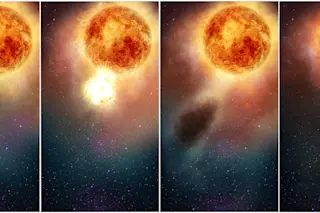This article appeared in Discover’s annual state of science issue as “The Supernova That Wasn't” Support our science journalism by becoming a subscriber.
For a while in 2020, the constellation Orion the Hunter looked like it was about to get a supernova shot in the arm. In January, Betelgeuse, one of the brightest stars in our sky — which forms Orion’s right shoulder — dimmed to levels unseen since modern observations began 150 years ago. Speculation about an imminent supernova followed the star’s every twinkle.
The Milky Way hasn’t had a supernova that’s visible from Earth since 1604, just a few years before Galileo turned his first telescope to the heavens. But was there really cause for all the excitement earlier this year?
Apparently not: In April, the dying red supergiant star let skygazers down by returning to its former glory.
Meanwhile, all the attention meant observatories were keeping a ...















